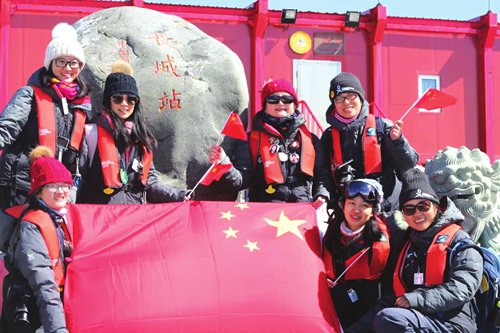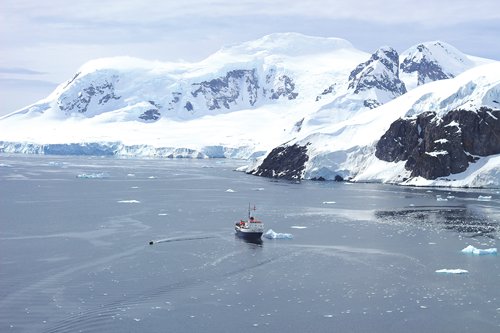
From the People's Daily app.
And this is Story in the Story.
On the last day of 2018, when people in China were counting down to the New Year, a group of female scientists in Ushuaia, Argentina, were boarding the ice-strengthened vessel, known as Ushuaia, and heading to the Antarctic for a three-week self-discovery journey.
90 Female scientists aged from 25 to 65 and from 26 countries were joining the Homeward Bound project, initiated by Australian entrepreneur and leadership coach Fabian Dattner and launched in 2016.
This project plans to bring 1,000 female scientists to the Antarctic over the course of 10 years and aims to “heighten the influence and impact of women in making decisions that shape our planet.” This year, seven Chinese scientists participated in this project.
During the project, these female scientists got the opportunity to explore the Antarctic and visit research stations in order to better study the ecology of the continent as well as our planet with their professional eye.
Today's Story in the Story looks at the journey of self-discovery that the Antarctic voyage has brought to the Chinese female scientists.

The seven Chinese scientists hold up a national flag at China's Great Wall Station in the Antarctic on January 3. (Photo: GT)
"This New Year's Eve is quite unreal," Luo Yi, 26, wrote in her "Antarctic diary" entry. She is one of the seven Chinese scientists who joined in the Homeward Bound project this year, and an entrepreneur in the field of urban and rural sustainable development in China.
On the ship, the Chinese scientists also outlined China's efforts in addressing climate change over the past years, which was highly praised by teammates from other countries.
After 48 hours at sea battling seasickness, members on the Ushuaia conquered Drake Passage and arrived at the Antarctic.
Their first stop was the Great Wall Station, China's first research station in Antarctica.
"We were all excited because we witnessed China's reform and opening-up. Our foreign teammates came to us, practicing saying 'ni hao' and 'xie xie' before we went to the station," Wang Binbin, a Beijing-based social scientist and a veteran of climate change issues, said.
On Thursday, January 3, the female scientists landed at the station.
The station has been in operation since 1985. At the beginning, it was only a one-floor building, the "No.1 Building," which covered most functions including dining, living and research.
After 34 years of development, the Great Wall Station is now a complex of more than 20 buildings. The "No.1 Building" has become a museum that showcases the history of China's exploration in the Antarctic.
"The most impressive part is the greenhouse in the station," Wang said. "Chinese scientists can plant vegetables in it, so that they can enjoy fresh cucumbers and tomatoes. This design shows the care and respect for the scientists."
"I had been used to seeing the world through statistics, but in the Antarctic, I felt figures could not describe the impact of what I saw there," Wang Chunguang, CEO of eQuota Energy, a Shanghai-based company that aims for a low-carbon future, said.

The ship Ushuaia carrying 90 female scientists traveling into the Antarctic. (Photo: GT)
As one of their tasks, the members were asked to conduct a silent exercise, during which they were told not to speak.
"During two or three hours of hiking, we heard at least 10 avalanches," Wang said.
"Combating climate change is not only for the future, but also related to everyone from our generation. If humans continue to mess up the environment, we are doomed," she said.
After two weeks of travel, the team landed on Deception Island, their last destination, on January 16.
"The C-shaped island made me think 'climate change' as soon as I saw it," Wang Binbin wrote in her last "Antarctic diary" entry.
On the way back to Ushuaia, the ship met a 12-meter wave passing the Drake Passage, the largest it could withstand.
"We woke up at midnight and 4 am, calling the captain to make sure if we were okay. He told us to stay in our cabins and wait," Wang Binbin said.
As they approached the harbor of Ushuaia, cell phone signals were resumed, and thousands of texts appeared on the scientists' phones, bringing them harshly back to their normal life.
"I had worked very hard and devoted all my time to my family and work. There was a moment that I wanted to escape. The Antarctic seemed to attract me," Lin Wuying, a researcher on natural conservation and a new mother, said.
Lin said that women face many choices in their lives, which brings a great deal of pressure. "The project gave us many chances to rethink things and know ourselves."
"I am lucky to meet women with different personalities from different cultural backgrounds, in different periods of life and positions in Homeward Bound at such a young age," Lu Zhiyao, program manager at the SEE Foundation, said, "I saw their unique beauty, the diversity and possibilities of women's lives, which encourage me to be braver and more real.”
"We are also planning to develop a course on leadership, and write a book," Lin said. "The world is big, and your dreams could be a little bit bigger," she said.
(Produced by Nancy Yan Xu, Lance Crayon, Brian Lowe, and Chelle Wenqian Zeng. Music by: bensound.com. Text from Global Times.)


